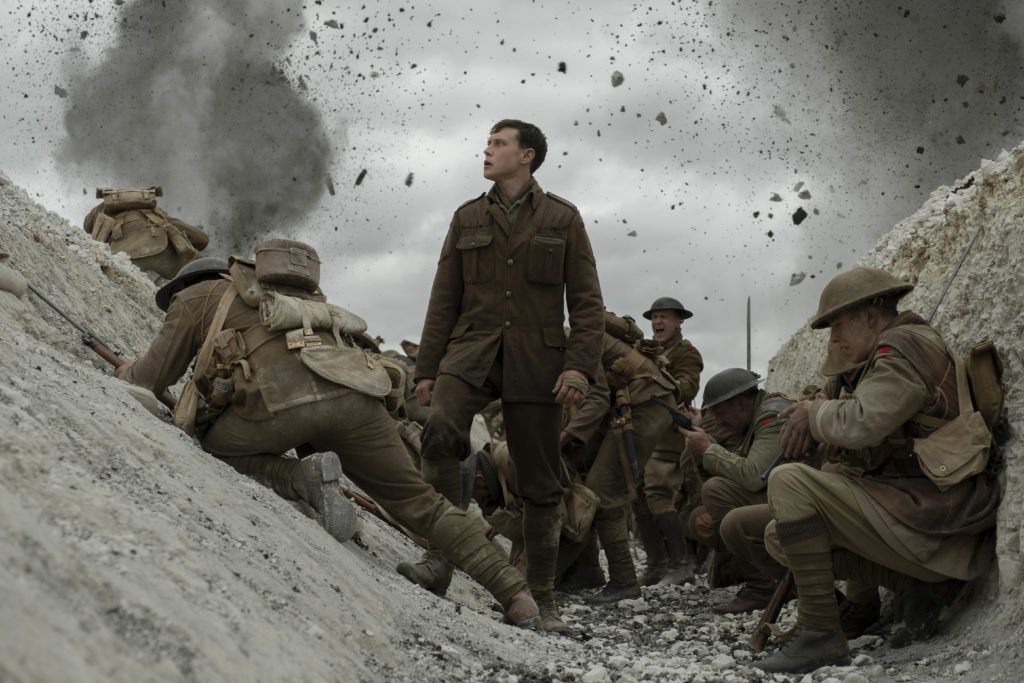1917

(center) George MacKay as Schofield in "1917," co-written and directed by Sam Mendes.
Read our extended interview with Golden Globes Best Director and Picture winner, Sam Mendes, here.
With a storied history dating back to the Napoleonic Wars (the Walcheren campaign of 1809), the 2nd Battalion of the Devonshire Regiment risks sending 1,600 troops to their deaths. To avert disaster, two messengers—Lance Corporals Blake (Dean-Charles Chapman) and Schofield (George MacKay)—must carry General Erinmore’s (Colin Firth) message to Colonel Mackenzie (Benedict Cumberbatch) at the front.
“Sarge tells me you’re good with maps,” says Erinmore to Blake. Of Colonel Mackenzie, Erinmore warns, “He’s convinced that we have them on the run. That if we break the lines, we will turn the tide. He is wrong.”
A nine mile journey, Schofield and Blake estimate it’ll take between six to eight hours on foot. From here, the 117-minute running length sprints in well-paced, 20 minute segments. Apropos, I timed the segments with a mechanical wristwatch—a century-old technology that’s been in my hands for at least a quarter that length. Today we transmit messages across the globe in milliseconds; the concept of two messengers without radios or GPS disorients us.
Directed and written by Sam Mendes, co-written by Krysty Wilson-Cairns , 1917 follows Blake and Schofield through trenches, across enemy fire, into Northern France and the Western Front. Based on the date, April 6, and their initial destination—Écoust-Saint-Mein—it’s likely that the story takes place just before the Battle of Arras led to over a quarter million combined casualties—160,000 British and 125,000 German. This little piece of the British Expeditionary Forces’ offensive is inspired by a story related to a young Sam by his grandfather and British novelist, Alfred Mendes, who fought in the 1st Rifle Brigade.
From Peter Watkins’ CULLODEN to Peter Weir’s GALLIPOLI, we can draw a straight line through the inspirations for Roger Deakins’ cinematographic opus. I say Deakins because while Mendes’ impressive command of locations and actors is essential to the structure and execution, camerawork drives the narrative content of this World War I drama. Going beyond steering our attention, trenches, arches, and landscapes form natural scene transitions without the conventions of editing which began with Griffith’s BIRTH OF A NATION¹ in 1915. But the real connection to its forebears lies in the scarcity of World War I stories, especially one dramatizing the race to avoid a costly battle.
Amidst the bodies, rats, enemy biplanes in dogfights, burning rubble, and piles and piles of spent artillery shells, Deakins’ handoffs between Steadicam and crane with the ARRI Alexa LF extends beyond mere gimmick. Even ten years ago, a multitude of firelit shots—punctuating diegesis of humanity and survival—would’ve proved almost impossible on 35mm or HDCAM. But it’s also the lightness of the rig that allows Deakins to switch off from lead to follow shots, to handheld dollying that might reveal a farmhouse through a doorway arch. He also makes use of deep focus, to draw our attention to a well, and away from a German soldier with a knife.
As much as it owes to picture and sound—Thomas Newman’s thrumming strings and pulses echoing Vangelis and Jean-Michel Jarre, whose Oxygène accompanied Weir’s film—1917 distinguishes itself from the technical exercise in DUNKIRK with depth of character dialogues. Enroute to Écoust, Blake and Schofield exchange stories, including how the latter “lost” his medal—traded for a bottle of wine, “It’s just a bit of bloody tin. It doesn’t make you special.”
Joseph Stalin, infamous for executing his own generals during the Red Army Purge, reportedly once said, “When one man dies it’s a tragedy. When thousands die it’s statistics.”
A visceral experience and visual masterclass, 1917 personalizes the immense scale of the only war to begin on horseback and end in the air. Mendes invests us in the fates of the two principal characters—one trying to reach his older brother, the other yearning for a brief respite from hell beneath a cherry blossom tree.
- Griffith’s virulently racist, albeit technically innovative, film, while not controversial for its time, stands as a reminder of why we fight.